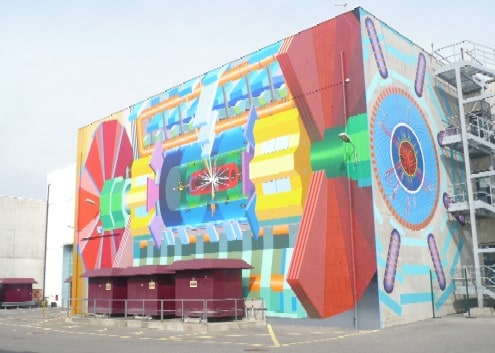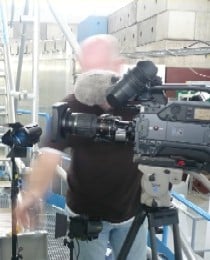
Mural of the inner workings of the ATLAS detector by Josef Kristofoletti
By James Dacey
I’m on a bit of a comedown today after spending the past two days whizzing around CERN with a film crew to record a series of short videos for physicsworld.com.
It was my second time at the particle-physics lab and I was inspired yet again by the enthusiasm of researchers and the way they discuss profound questions of nature as if they were chatting about last night’s football or the weather.
My previous CERN visit was last March just after the Large Hadron Collider (LHC) had achieved its first collisions at 7 TeV and the physics programme was finally under way.
A year down the line and researchers across CERN’s various experiments have collected plenty of data to analyse and big physics results could be just around the corner.
One of our videos will look at the hunt for the Higgs boson and for physics beyond the Standard Model. We interviewed scientists from the LHC’s two general purpose detectors, CMS and ATLAS and both seemed fairly confident that they will have collected enough data by the end of 2012 (when the LHC will be shutdown for at least a year) to have a decent crack at finding the elusive Higgs. If indeed it exists!
Both scientists were also excited by the prospect of discovering SUSY particles to advance the theory of supersymmetry. This is the idea that every boson has a partner fermion with identical mass and internal quantum numbers.

A separate video will look at the LHC’s ALICE experiment, which is designed to recreate the moments that existed just picoseconds after the Big Bang. I was particularly excited about this project because it meant I could interview my old university tutor, David Evans, who is head of the UK team at ALICE.
Evans was clearly really proud of his “girl” who apparently showed excellent performance recording data at the end of last year when the LHC collided lead ions instead of protons. The idea behind this is to create and study a state of matter known as quark-gluon plasma that may have existed at the very beginning of the universe.
But while news from CERN tends to be dominated these days by the LHC and its search for fundamental particles, there is plenty of other science going on there. Another video will look at one of these experiments, known as CLOUD, which is designed to study processes in the Earth’s atmosphere and the effect these could have on the climate.
Then in our final video we change direction again by exploring the CERN arts programme, which is seeing something of a renaissance under the leadership of Ariane Koek. Ariane, who has been employed to develop a cultural policy for CERN, explained to me that her big idea is to break down the barriers between art and science by creating opportunities for artists to come to CERN to collaborate with scientists.
All of these short films have now entered the post-production phase, but watch this space because they will be appearing on physicsworld.com over the next few weeks.



